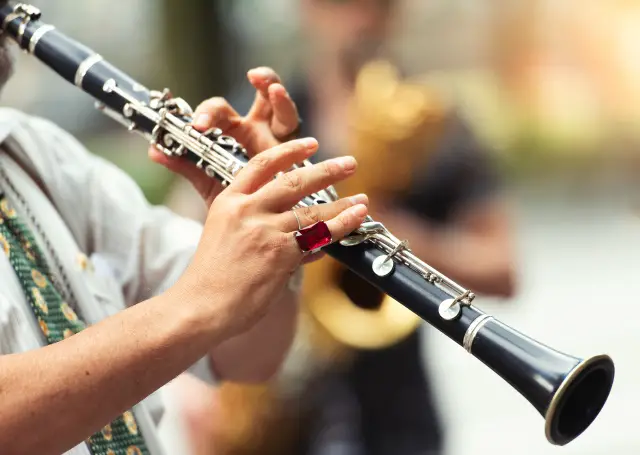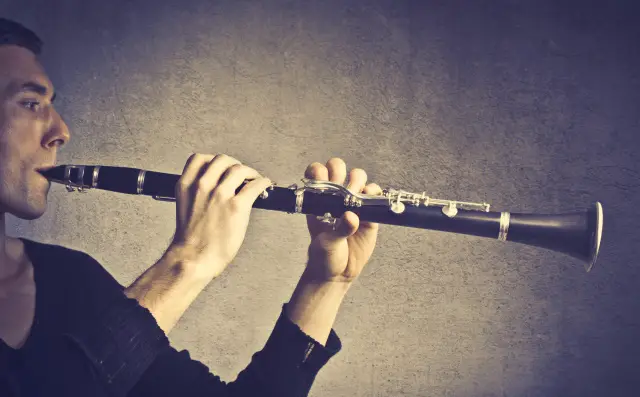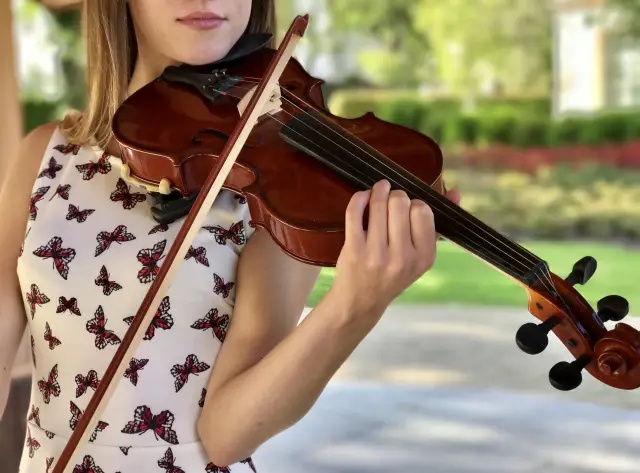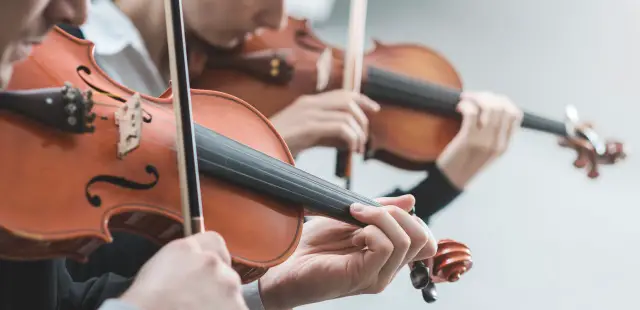So you or your child have decided to learn an instrument, and you’ve narrowed it down to be either the violin or the clarinet. In order to choose between the two, you might be wondering which of these two instruments is harder to learn and to play.
The violin is widely considered harder to learn and play. The diverse basic techniques required to produce a decent sound on the violin, and the time needed to master them, make the violin a very complex instrument to learn. As a fixed-pitch instrument, the clarinet is easier to learn.
There are, however, many aspects to consider when determining an instrument’s degree of difficulty. These include how difficult it is to learn the basics, how much time does it take to get decent on-pitch notes produced, and which instrument is the best suited for a child to learn.
Table of Contents
Is the clarinet or the violin harder to learn?

Ask musicians and music teachers to list musical instruments from most difficult to learn to the least difficult, and the violin frequently ranks as one of the most difficult instruments.
As part of the string family, the violin has inherent characteristics which make it hard to learn. It has no keys or marks to indicate where to place your finger on the string to produce a specific note. Your ears also have to be trained to determine whether a note is on pitch.
It’s also hard to master the bow technique with the right hand, while the left hand is practicing to find the right harmonic places on the strings. Getting used to two hands engaging in completely different types of movement at once, can take months to get comfortable with.
As a result, it can take quite a while before a new learner can produce one or two decent notes.
The clarinet is easier than the violin in the sense that it is designed in a way that each combination of keys pressed gives a specific pitch. You also use both hands on the keys, which makes coordination between the hands much easier than with a violin.
Although it takes a while to learn the technique to use the mouthpiece and reed correctly, a new clarinet player could be ready within a few weeks to play the first notes.
Learning the basics: which is harder?
The clarinet has fewer basics to learn than the violin, and the violin’s basics are much more complex.
The clarinet’s basic fingering is relatively easy to learn. It only plays one melodic line at a time and beginners generally start by using sheet music where the fingering is printed below the score.
As the learning process progresses the fingering becomes more and more intuitive.
The hardest part of the learning path for the clarinet centers around the mouthpiece and reed. In the beginning, it takes time to learn the basics of how to correctly use the body’s diaphragm and how to develop an embouchure, including tonguing.
Generally speaking, most of the basics a new clarinet player has to master are linked to the air generating process, which is less complicated than the violin’s bow and fingering techniques.
With the violin, there are many more basic aspects to learn compared to the clarinet. Not only do you have to learn the right posture for playing, but you also have to learn left-hand basics to play the correct pitch, as well as right-hand basics for using the bow.
You have to practice all these basic techniques simultaneously to get a balance between the skills, which enable you to play this complex instrument.
Getting a decent sound: which is harder?

Both the new violist and the clarinet player in the making have challenges to overcome before a decent sound is being produced
On the violin, it takes time to produce any decent sound that doesn’t sound scratchy or off-pitch. To achieve the right tone quality, articulation, changes in timbre and dynamics, your right arm and hand and the bow are being used.
To produce the desired pitch, with your left hand on the strings you have to be alert to adjust your fingers instantly if the sound you hear is not the note you desire.
For beginners, the coordination between the hands can be very difficult, which greatly contributes to the challenge of getting a decent sound on the violin.
To produce a good sound on the clarinet, the most difficult part is to learn how to blow into the mouthpiece through the single reed. Once you’ve reached an acceptable degree of blowing technique, you only have to learn the fingerings for the different notes.
Using your elementary blowing technique which allows you to produce sounds without too much squeaking, you apply the fingering for a specific pitch and you are on your way. Your fingers need to ensure the appropriate holes are properly closed.
Intonation: which is harder?

Per definition, intonation is the degree to which notes of a piece of music are played exactly in tune on the instrument. For the beginner, both string instruments and woodwind instruments offer intonation challenges.
However, string instruments like the violin are even more challenging compared to the clarinet. A clarinet has fixed pitch and therefore the new clarinet player only has to concentrate on the mouth position and airflow (embouchure) to produce in-tune notes.
A new violist could even have mastered a relatively good bow technique, and still not be able to produce the correct pitch. A tiny change in finger position causes a big difference in intonation.
With the violin, you always need to listen carefully whether the note you are producing is on pitch. A clarinet player, on the other hand, can sometimes successfully produce a sound without paying that much attention to the intonation – the clarinet with its fixed-pitch will in most instances produce on-pitch notes.
Learning as a child: which is harder?
As fractional violins are available, small children can start at a very young age even when a full violin is too large to handle. The average age for children to start violin lessons is between 4 and 7 years.
At that young age, children are only taught the very basic principles. The child can experience playing the violin without too much effort as many teachers also mark finger positions on the ¾ violin to indicate different pitches.
Thus, looking from this angle, it is not hard for a child to start with violin lessons at a very young age and still find it relatively easy. Ironically it becomes harder for the child the longer s/he takes lessons, as s/he has to learn new more difficult techniques.
This may be the reason why many children who have started with violin lessons at a young age stop playing the violin after a certain time as they encounter more challenging aspects.
Learning the clarinet as a child
Generally, children don’t start with clarinet lessons when they are younger than 10 to 11 years – and even that age can be too early. As a clarinet is designed for the lung and mouth power of an adult, a young child has difficulty with the airflow and mouth techniques.
Starting too young, a child could find the clarinet too difficult to play. In contrast, if the lessons start at age 15 or 16, there are greater chances the child will keep on playing.
Mastering the instrument: which is harder?

After you’ve learned the basics of either the violin or the clarinet, it becomes more difficult to distinguish which instrument is harder to master.
It depends to a great extent not only on your musicality and skill level, but also on how frequently you practice and play your instrument.
Another important aspect is whether you are developing into a professional player, or only play the instrument as a hobby.
Violin
When you start with violin lessons, you have to realize that you’ll be facing a steep learning curve. It takes players at least three years to reach a skill level where they can comfortably play in public, whether as a soloist or in an ensemble.
To be a master of your instrument you also have to learn other techniques, like pizzicato, where the note is played by plucking the string with a finger; col legno, where the strings are struck with the back of the bow; and détaché, where the bow is stopped on the string to create a muted accent, to name a few.
If you have a very good pitch (albeit not necessarily perfect), you will take a shorter period to master the technique to always play on pitch. On the other hand, people without natural good pitch very seldom masters the violin completely.
Becoming a professional violist may not be that hard, but it takes a lot of dedication, patience, and practice.
Clarinet
The same can be said about the clarinet. The clarinet player also needs dedication and many practice sessions to master the instrument. However, the learning curve is much shorter as with a violin.
As discussed, the main challenges a clarinet player needs to overcome in the beginning have to do with embouchure and breath control. The manipulation of key-sequences might also be difficult to master, but once these different techniques are mastered, playing the clarinet becomes much easier.
Playing the upper registers, however, always remains a challenge, including for professional players. To consistently produce acceptable and on-pitch notes across the whole possible range requires highly developed skills.
Final words
When looking at all the different techniques and skills needed to play the violin vs the clarinet, it can be concluded it is harder to achieve success with the violin.
However, which is harder also depends on the individual. People just naturally take to different kinds of instruments. Some will do better with a string instrument and others with a woodwind instrument.
And lastly, it will take longer with the violin as with the clarinet to master all the skills needed to be a professional player.

